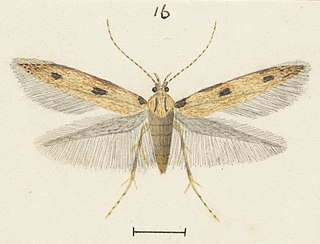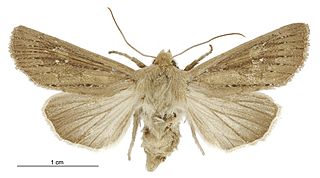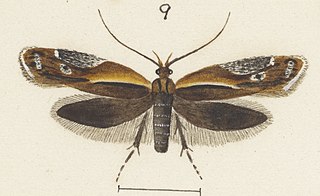
Sabatinca calliarcha is a species of moth belonging to the family Micropterigidae. It was described by Edward Meyrick in 1912. It is endemic to New Zealand. It is found in two separate areas of New Zealand - the first in the norther parts of the North Island including Great Barrier Island and the second population can be found from the top of the South Island down to Southland. The adults of the species are on the wing from the end of September until the middle of January. The species prefers to inhabit damp forests and larvae likely feed on leafy liverwort species. Adult moths likely feed on the spores of ferns or the pollen of sedge grasses.

Eutorna tricasis is a moth of the family Depressariidae. It is found in Australia, where it has been recorded from the eastern part of the country.

Pyroderces aellotricha, also known as the Cosmet moth, is a moth of the family Cosmopterigidae. It is found in New Zealand, in Australia and the Cook Islands.

Labdia anarithma is a moth of the family Cosmopterigidae. It was described by Edward Meyrick in 1888. It is found in New Zealand and throughout Australia. Adults are on the wing from December to March and are day flying. They have been collected by sweeping bracken fern.

Ichneutica lissoxyla is a moth of the family Noctuidae. It is endemic to New Zealand. It is found in the central and southern parts of the North Island and in most parts of the South Island. The species prefers snowgrass habitat in the alpine zone. I. lissoxyla is similar in appearance to I. paraxysta but can be distinguished as I. lissoxyla lack the black streaks on the forewings that can be found on the latter species and the male I. lissoxyla also has longer pectinations on antennae. The life history of this species is unknown as are the host species of its larvae. Adults are on the wing from January to April and are attracted to the light.

Ichneutica scutata is a moth of the family Noctuidae. It is endemic to New Zealand. This species can be found in the southern parts of the North Island as well as the eastern parts of the South Island. It is similar in appearance to I. insignis and I. skelloni but can be distinguished as I. scutata is much paler in appearance. It is likely this species inhabits lowland tussock grasslands as well as coastal dunes although it is not common in inland tussock grasslands. The larvae feed on a variety of herbaceous plants such as Plantago and Convolvulus species, Plagianthus divaricatus. It pupates on soil near its host plants. The adults are on the wing from late March to July.

Ichneutica phaula is a moth of the family Noctuidae. It is endemic to New Zealand. It is found only in the South Island in the Nelson district, the eastern side of the South Island and Stewart Island. I. phaula inhabits tussock grasslands and coastal sand dunes. Host species include Ficinia spiralis, Ammophila arenaria, Poa cita and other "tussock grasses". The adults of this species are on the wing from October to December and are attracted to sugar traps. I. phaula is similar in appearance to both I. micastra, with whom it does not share a range, and I. sapiens which differs from I. phaula as I. sapiens is darker and has a more reddish tinge.

Ichneutica steropastis, or the flax notcher moth, is a species of moth in the family Noctuidae. It is endemic to New Zealand and can be found throughout the country from the Three Kings Islands to Stewart Island as well as in the Chatham Islands. The larvae of this species feed on a variety of native and introduced plants however the New Zealand flax is one of the more well known host plants for the larvae of this moth. The larvae are nocturnal, hiding away in the base of the plants and coming out to feed at night. They create a distinctive notch in the leaf when they feed. The adults of this species are on the wing from October to March. Although adult specimens of I. steropastis are relatively easy to recognise they might possibly be confused with I. inscripta, I. theobroma or with darker forms of I. arotis. However I. steropastis can be distinguished as it has a long dark basal forewing streak that these three species lack.

Pyrgotis plinthoglypta is a species of moth of the family Tortricidae. It is endemic to New Zealand and is found throughout the whole country. The preferred habitat of this species is native forest. The larvae of this species feeds on rimu leaves from under a silken web. It pupates in loose cocoons amongst rimu foliage. Adults are on the wing from October to May and are night flying. They are attracted to light and can be collected by beating their host tree. The adult insect resembles a small dried fragment of rimu foliage when at rest.
Garrha rufa is a moth in the family Oecophoridae. It was described by Edward Meyrick in 1883. It is found in Australia, where it has been recorded from New South Wales.
Helcystogramma phryganitis is a moth in the family Gelechiidae. It was described by Edward Meyrick in 1911. It is found in Sri Lanka.
Ardozyga haemaspila is a species of moth in the family Gelechiidae. It was described by Oswald Bertram Lower in 1894. It is found in Australia, where it has been recorded from New South Wales and South Australia.
Eutorna intonsa is a moth in the family Depressariidae. It was described by Edward Meyrick in 1906. It is found in Australia, where it has been recorded from Victoria, New South Wales and Tasmania.
Eutorna pabulicola is a moth in the family Depressariidae. It was described by Edward Meyrick in 1906. It is found in Australia, where it has been recorded from Queensland and New South Wales.

Eutorna caryochroa is a species of moth in the family Depressariidae. It was described by Edward Meyrick in 1889 and is endemic to New Zealand. This species is found in both the North and South Islands. The larvae of this species are leaf miners and prefer damp grassland habitat. The adults are on the wing in December and January. They are day flying moths, they frequent forest and scrub, and have a habit of basking on leaves in the sunshine. They have been collected by beating shrubbery.
Eutorna diluvialis is a moth in the family Depressariidae. It was described by Edward Meyrick in 1913. It is found in Madagascar, South Africa and the Democratic Republic of the Congo (Orientale).
Eutorna generalis is a moth in the family Depressariidae. It was described by Edward Meyrick in 1921. It is found on Java and in Australia.
Eutorna insidiosa is a moth in the family Depressariidae. It was described by Edward Meyrick in 1910. It is found in India (Assam).

Ichneutica paraxysta is a moth of the family Noctuidae. It is endemic to New Zealand. This species is very similar in appearance to its close relative I. acontistis but as the range of the two species do not overlap this is unlikely to cause confusion. I. paraxysta is only found in the North Island at the subalpine zones in the Mount Taranaki region and at Mount Ruapehu. It prefers tussock grassland and shrubland habitat. The life history of this species is unknown as are the host species of its larvae however it has been hypothesised that the larval host plants are species in the genera of Poa and Festuca.

Ichneutica paracausta is a moth of the family Noctuidae. This species is endemic to New Zealand. It is found locally in the central North Island, is widespread in the South Island and can also be found in Stewart Island. I. paracausta is variable in colour, but as it has a distinctive black streak on its forewing as well as a wing pattern that is characteristic, I. paracausta is unlikely to be confused with other species. It is present on the North Island volcanic plateau as well as Little Bush Reserve in Hawkes Bay in the North Island as well as in tussock grassland, alpine and subalpine shrubland and in alpine forest. Larvae have been recorded as feeding on grasses, a pupa has been found in a cocoon under the bark of a tree and adult moths are on the wing from October to January.












